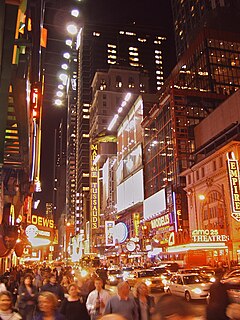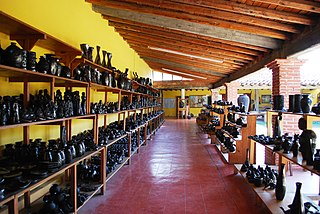Related Research Articles

Douglas Gordon is a Scottish artist. He won the Turner Prize in 1996, the Premio 2000 at the 47th Venice Biennale in 1997 and the Hugo Boss Prize in 1998. He lives and works in Berlin, Germany.

In the signage industry, neon signs are electric signs lighted by long luminous gas-discharge tubes that contain rarefied neon or other gases. They are the most common use for neon lighting, which was first demonstrated in a modern form in December 1910 by Georges Claude at the Paris Motor Show. While they are used worldwide, neon signs were popular in the United States from about the 1920s to 1950s. The installations in Times Square, many originally designed by Douglas Leigh, were famed, and there were nearly 2,000 small shops producing neon signs by 1940. In addition to signage, neon lighting is used frequently by artists and architects, and in plasma display panels and televisions. The signage industry has declined in the past several decades, and cities are now concerned with preserving and restoring their antique neon signs.

Dan Flavin was an American minimalist artist famous for creating sculptural objects and installations from commercially available fluorescent light fixtures.

Robert W. Irwin is an American installation artist who has explored perception and the conditional in art, often through site-specific, architectural interventions that alter the physical, sensory and temporal experience of space.

Glenn Ligon is an American conceptual artist whose work explores race, language, desire, sexuality, and identity. Based in New York City, Ligon's work often draws on 20th century literature and speech of 20th century cultural figures such as James Baldwin, Zora Neale Hurston, Gertrude Stein, Jean Genet, and Richard Pryor. He is noted as one of the originators of the term Post-Blackness.

San Pablo de Mitla is a town and municipality in Mexico which is most famous for being the site of the Mitla archeological ruins. It is part of the Tlacolula District in the east of the Valles Centrales Region. The town is also known for its handcrafted textiles, especially embroidered pieces and mezcal. The town also contains a museum which was closed without explanation in 1995, since when its entire collection of Zapotec and Mixtec cultural items has disappeared. The name “San Pablo” is in honor of Saint Paul, and “Mitla” is a hispanization of the Nahuatl name “Mictlán.” This is the name the Aztecs gave the old pre-Hispanic city before the Spanish arrived and means “land of the dead.” It is located in the Central Valleys regions of Oaxaca, 46 km from the city of Oaxaca, in the District of Tlacolula.

Neon lighting consists of brightly glowing, electrified glass tubes or bulbs that contain rarefied neon or other gases. Neon lights are a type of cold cathode gas-discharge light. A neon tube is a sealed glass tube with a metal electrode at each end, filled with one of a number of gases at low pressure. A high potential of several thousand volts applied to the electrodes ionizes the gas in the tube, causing it to emit colored light. The color of the light depends on the gas in the tube. Neon lights were named for neon, a noble gas which gives off a popular orange light, but other gases and chemicals are used to produce other colors, such as hydrogen (red), helium (yellow), carbon dioxide (white), and mercury (blue). Neon tubes can be fabricated in curving artistic shapes, to form letters or pictures. They are mainly used to make dramatic, multicolored glowing signage for advertising, called neon signs, which were popular from the 1920s to 1960s and again in the 1980s.

The Museum of Contemporary Art San Diego, in San Diego, California, US, is an art museum focused on the collection, preservation, exhibition, and interpretation of works of art from 1950 to the present.

Barro negro pottery is a style of pottery from Oaxaca, Mexico, distinguished by its color, sheen and unique designs. Oaxaca is one of few Mexican states which is characterized by the continuance of its ancestral crafts, which are still used in everyday life. Barro negro is one of several pottery traditions in the state, which also include the glazed green pieces of Santa María Atzompa; however, barro negro is one of the best known and most identified with the state. It is also one of the most popular and appreciated styles of pottery in Mexico. The origins of this pottery style extends as far back as the Monte Albán period and for almost all of this pottery's history, had been available only in a grayish matte finish. In the 1950s, a potter named Doña Rosa devised a way to put a black metallic like sheen onto the pottery by polishing it before firing. This look has made the pottery far more popular. From the 1980s to the present, an artisan named Carlomagno Pedro Martínez has promoted items made this way with barro negro sculptures which have been exhibited in a number of countries.
Larry Bell is an American contemporary artist and sculptor. He is best known for his glass boxes and large-scaled illusionistic sculptures. He is a grant recipient from, among others, the National Endowment for the Arts and the Guggenheim Foundation, and his artworks are found in the collections of many major cultural institutions. He lives and works in Taos, New Mexico, and maintains a studio in Venice, California.

De Wain Valentine is an American minimalist sculptor who was born in Fort Collins, Colorado. Often associated with the Light and Space movement in the 1960s, he is best known for his minimalist sculptures of translucent glass, fiberglass and cast polyester resin having slick surfaces suggestive of machine made objects. He lives and works in Gardena, California.

Richard Harned is an American contemporary kinetic sculptor and glass artist. Harned trained under Dale Chihuly in the 1970s at the Rhode Island School of Design (RISD) with other artists of the American Glass Movement, including Bruce Chao and Tom Kreager. In 1974, he established the Abstract Glass studio in Providence, Rhode Island. After graduating from and teaching at RISD, he also taught glass art at Arkansas State University in Jonesboro and the University of Tennessee. He joined the faculty of Ohio State University in 1982.

San Bartolo Coyotepec is a town and municipality located in the center of the Mexican state of Oaxaca. It is in the Centro District of the Valles Centrales region about fifteen km south of the capital of Oaxaca.

Light and Space denotes a loosely affiliated art movement related to op art, minimalism and geometric abstraction originating in Southern California in the 1960s and influenced by John McLaughlin. It was characterized by a focus on perceptual phenomena, such as light, volume and scale, and the use of materials such as glass, neon, fluorescent lights, resin and cast acrylic, often forming installations conditioned by the work's surroundings. Whether by directing the flow of natural light, embedding artificial light within objects or architecture, or by playing with light through the use of transparent, translucent or reflective materials, Light and Space artists made the spectator’s experience of light and other sensory phenomena under specific conditions the focus of their work. They were incorporating into their work the latest technologies of the Southern California-based engineering and aerospace industries to their develop sensuous, light-filled objects. Turrell, who has spread the movement worldwide, summed up its philosophy in saying, "We eat light, drink it in through our skins."

The Harwood Museum of Art is located in Taos, New Mexico. Founded in 1923 by the Harwood Foundation, it is the second oldest art museum in New Mexico. Its collections include a wide range of Hispanic works and visual arts from the Taos Society of Artists, Taos Moderns, and contemporary artists. In 1935 the museum was purchased by the University of New Mexico. Since then the property has been expanded to include an auditorium, library and additional exhibition space.
Sarah Cain is an American contemporary artist who lives and works in Los Angeles, California.
Jean Wells is an American artist known for her large-scaled and life-sized mosaic sculptures featuring pop-inspired objects such as ice cream cones, hamburgers, hot dogs, and candy. Like artists Andy Warhol and Jeff Koons, Wells offers consumerist images without obvious critique, yet subtle indications are detected by some who see clues to ideological substance beneath her works.

Robert Kehlmann is an artist and writer. He was an early spokesperson for evaluating glass art in the context of contemporary painting and sculpture. His glasswork has been exhibited worldwide and is the focus of numerous commentaries. Kehlmann's work can be found in museums and private collections in the United States, Europe and Asia. He has written books, articles, and exhibition reviews for publications in the U.S. and abroad. In 2014 the Rakow Research Library of The Corning Museum of Glass acquired Kehlmann's studio and research archives.

The Quin is a luxury hotel in New York City. It is located on 57th Street and Sixth Avenue in Midtown Manhattan, two blocks south of Central Park.

Rob Wynne is an American visual artist best known for his use of glass to produce abstract and text wall installations. He lives and works in New York City.
References
- ↑ Biograph and images Retrieved December 30, 2010
- ↑ Harwood Museum Retrieved February 10, 2011
- ↑ UNM, Hickey Leads Panel on ‘Hopper at the Harwood’ Archived 2011-07-20 at the Wayback Machine Retrieved February 10, 2011
- ↑ "Awards Search | James Beard Foundation". www.jamesbeard.org. Retrieved 2020-06-25.